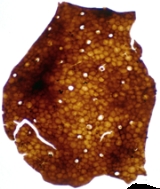
Cosmochlaina
Encyclopedia
Cosmochlaina is a form genus of nematophyte – an early (Siluran – Devonian) plant known only from fossil cuticles, often found in association with tubular structures. Where Nematothallus is sometimes used to relate only to tube-like structures, Cosmochlaina refers to the cuticle fragments. The form genus was put forwards by Dianne Edwards, and is diagnosed by inwards-pointing flanges and randomly oriented pseudo-cellular units. Projections on the outer surface are always present, and sometimes also appear on the inner surface; however, the surface of the cuticle itself is always smooth. The holes in the cuticle are often covered by round flaps, loosely attached along a side.
It has been suggested that the pores of Cosmochlaina represent broken-off rhizoids, on the basis that rotting and acid treatment of extant liverworts produces a similar perforated texture. However, the status of this form genus in any one kingdom is not secure; members could, for example, represent arthropod cuticle. Alternatively, different species may in fact represent different parts of the same organism.
It has been suggested that the pores of Cosmochlaina represent broken-off rhizoids, on the basis that rotting and acid treatment of extant liverworts produces a similar perforated texture. However, the status of this form genus in any one kingdom is not secure; members could, for example, represent arthropod cuticle. Alternatively, different species may in fact represent different parts of the same organism.
See also
- NematothallusNematothallusNematothallus is a form genus comprising cuticle-like fossils.- History of research :Nematothallus was first described by Lang in 1937, who envisioned it being an early thallose land plant with tubular features and sporophytes, covered by a cuticle which preserved impressions of the underlying cells...
, a closely related sister taxon - Evolutionary history of plantsEvolutionary history of plantsThe evolution of plants has resulted in increasing levels of complexity, from the earliest algal mats, through bryophytes, lycopods, ferns to the complex gymnosperms and angiosperms of today...

